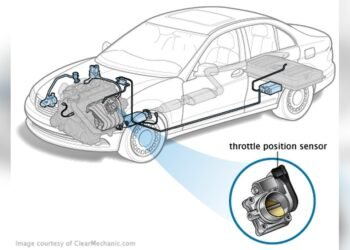To troubleshoot an overheating Toyota, first check the coolant level and radiator condition. Next, inspect the thermostat, water pump, and cooling fans for proper function.
Overheating in a Toyota can be a driver’s nightmare, signaling potential damage to your vehicle’s engine and associated components. The key to resolving this issue lies in identifying the root cause quickly and efficiently. A well-maintained cooling system is crucial for the health of your Toyota, as it prevents the engine from reaching damaging temperatures.
Regular checks of the coolant levels, along with inspections of the radiator, hoses, and clamps, can preempt many overheating problems. Recognizing signs of a malfunctioning thermostat, a failing water pump, or cooling fans that aren’t operating can save you time and costly repairs. Early detection of these issues not only keeps your Toyota running smoothly but also ensures that you remain safe on the road. Addressing overheating immediately can help maintain your vehicle’s longevity and performance.
Introduction To Toyota Overheating Issues
Overheating is a critical problem for any vehicle, including Toyota models. It can lead to major engine damage if not addressed promptly. Understanding the common signs and potential risks of an overheating Toyota can save you time and money.
Common Symptoms Of Overheating
- High temperature gauge readings
- Steam from the hood
- Engine knocking sounds
- Reduced engine performance
- Strange smells from the engine area
Potential Consequences Of Ignoring The Problem
- Engine failure: Most severe outcome, costly repair or replacement needed.
- Head gasket damage: Leads to oil and coolant leaks, expensive to fix.
- Warped or cracked engine components: High repair costs, may cause engine breakdown.
- Decreased vehicle value: Long-term overheating drops resale price.
- Increased fuel consumption: Inefficient engine performance, more fuel used.

Credit: www.reddit.com
Identifying The Root Causes
When your Toyota starts overheating, it’s crucial to pinpoint the issue. A car’s temperature spike can lead to serious damage. By understanding common problems, you can tackle them head-on. Let’s dive into the typical causes of overheating and how to fix them.
Coolant System Leaks
Leaking coolant is a primary cause of overheating. Coolant keeps the engine at the right temperature. A leak means the engine isn’t getting cooled properly. Check for puddles under your car. They often indicate a leak. Hoses, the radiator, and the head gasket are usual suspects.
- Check hoses for cracks or splits.
- Inspect the radiator for corrosion or damage.
- A head gasket leak needs immediate attention.
Malfunctioning Thermostat
The thermostat regulates engine temperature. A broken one can cause your Toyota to overheat. It might not open, stopping coolant flow. This leads to a temperature rise. Replace a faulty thermostat to solve this problem.
- Watch for a stuck gauge on the dashboard.
- Feel the upper radiator hose for warmth.
Radiator Issues
Radiators dispel heat from the engine. Clogs or damage stop this process. A clogged radiator needs cleaning or replacement. Check the fins for blockages. Make sure the radiator cap seals well. A poor seal can cause overheating.
- Clean blocked fins carefully.
- Ensure a tight seal on the cap.
Water Pump Failures
The water pump circulates coolant. A failed pump can’t move coolant, leading to heat build-up. Listen for whining sounds from the pump area. A leak near the pump also signals trouble. Replace the pump if it’s not working right.
- Listen for unusual noises near the pump.
- Spot leaks to confirm a pump issue.
Immediate Actions To Take
When a Toyota overheats, quick action is crucial. Avoid engine damage by following these steps. Let’s dive into the immediate actions to take.
Safely Pulling Over
Find a safe spot and pull over. Turn on your hazard lights. This signals others that you’re having trouble.
Shutting Down The Engine
Turn off the engine right away. This stops more heat from building up.
Checking Coolant Levels
- Wait for the engine to cool.
- Open the hood to help the engine cool faster.
- Check the coolant reservoir. It’s usually transparent with level markings.
If low, add coolant. But never open the radiator cap while hot.

Credit: m.youtube.com
Quick Fixes On The Road
Quick Fixes on the Road: Picture this – you’re driving and suddenly, your Toyota starts overheating. Don’t panic! Some quick, temporary fixes can help you manage this stressful situation and possibly prevent damage to your engine.
Temporary Solutions To Reduce Engine Temperature
Act fast when your Toyota’s temperature gauge rises. Here’s what you can do:
- Turn off the A/C – This reduces engine strain.
- Turn on the heater – It sounds counterintuitive, but it draws heat away from the engine.
- Pull over safely – Let your engine cool down.
- Check coolant levels – If low, top it up carefully.
- Inspect for leaks – Coolant on the ground indicates a problem.
When To Call For Professional Help
If these steps don’t work, seek professional help. Here’s when:
- Steam from the hood – Indicates a serious issue.
- Engine warning light – Your car’s telling you it needs a mechanic.
- Persistent high temperature – Continuous overheating needs expert attention.
- Odd noises or smells – These are signs of potential engine damage.
Remember, these tips are temporary fixes. Always consult a professional to address the root cause of the overheating.
Maintaining Your Cooling System
Keeping your Toyota running smoothly involves cooling system care. Prevent overheating with simple maintenance steps. This guide will show you how.
Regular Coolant Flushes
Coolant flushes are vital for your Toyota. They keep the engine at the right temperature. Over time, coolant becomes acidic. This can damage parts. Experts suggest flushing every 30,000 miles. Always use the correct coolant type.
- Turn off the engine
- Wait for cooling
- Drain old coolant
- Refill with new coolant
- Check for leaks
Checking Hoses And Belts
Hoses and belts need regular checks. They can crack or soften over time. Look for signs of wear. Squeeze hoses near clamps. Feel for soft spots. Replace if needed. Belts should be tight and intact. A loose belt can lead to overheating.
| Part | Check for | Action |
|---|---|---|
| Hoses | Cracks, leaks | Replace if damaged |
| Belts | Tension, wear | Adjust or replace |
Thermostat Checks
A working thermostat is key. It controls coolant flow. Ensure it opens and closes properly. A stuck thermostat causes overheating. Test or replace it regularly. This keeps the engine cool.
- Remove the thermostat
- Test in hot water
- Watch for opening
- Replace if faulty
Upgrading Your Toyota’s Cooling Capacity
Upgrading Your Toyota’s Cooling Capacity can prevent overheating. It ensures your car runs smoothly. This upgrade is crucial for Toyota’s longevity. Let’s explore options to boost your car’s cooling system.
Performance Radiators
Performance radiators handle extreme heat. They are key in cooling upgrades. Made from high-quality materials, they last longer. They improve heat dissipation.
- Bigger cores increase surface area.
- Aluminum construction enhances cooling.
- Better flow reduces engine strain.
High-flow Water Pumps
Upgrade to a high-flow water pump for better circulation. It moves coolant faster. This means better engine temperature control.
| Feature | Benefit |
|---|---|
| Increased flow rate | Quicker cooling |
| Quality materials | Durable and reliable |
Cooling System Additives
Cooling system additives complement other upgrades. They are easy to use. Additives improve heat transfer.
- Reduce coolant surface tension.
- Enhance thermal conductivity.
- Help prevent corrosion.
Professional Diagnosis And Repairs
When your Toyota overheats, it needs expert care. Professional Diagnosis and Repairs ensure your car gets back to its best shape. Let’s explore why choosing a certified mechanic matters, common repair procedures, and your warranty and service options.
Benefits Of A Certified Mechanic
- Expertise: Trained on Toyota models.
- Tools: They use the right tools for your car.
- Parts: Access to genuine Toyota parts.
- Peace of Mind: Trust in their skills.
Common Repair Procedures
Common fixes for an overheating Toyota include:
- Checking and replacing the coolant.
- Inspecting the radiator for leaks or blockages.
- Testing the thermostat.
- Examining the water pump.
Each step is vital to find and fix the issue.
Warranty And Service Options
| Service | Warranty | Benefits |
|---|---|---|
| Standard Check-up | 6 Months | Ensures car health |
| Complete Repair | 1 Year | Covers all fixes |
Choosing a service with a good warranty offers long-term benefits.
Prevention: Best Practices To Avoid Overheating
Keeping your Toyota cool is vital for a smooth ride. Overheating can cause serious damage. Follow these best practices to prevent it.
Driving Habits That Reduce The Risk
- Avoid long idles.
- Use air conditioning sparingly.
- Monitor gauge and lights.
Warning Signs To Watch For
- Steam from the hood is a red flag.
- Hot hood to the touch signals trouble.
- Temperature gauge spikes? Act fast.
Essential Maintenance Schedule
| Interval | Service |
|---|---|
| Every 5,000 miles | Oil and filter check |
| Every 15,000 miles | Coolant flush and replace |
| Annually | Inspect belts and hoses |

Credit: m.youtube.com
Frequently Asked Questions
Why Does My Toyota Keep Overheating?
Your Toyota may overheat due to a malfunctioning thermostat, a leak in the cooling system, a broken water pump, clogged radiator, or insufficient coolant levels. Regular maintenance checks can prevent these issues.
How Do I Diagnose What’s Making My Car Overheat?
To diagnose car overheating, check the coolant level first. Inspect the radiator and hoses for leaks. Evaluate the thermostat, water pump, and radiator fan for proper function. Monitoring these components can reveal the cause of the issue.
How Can I Fix My Overheating Problem?
To fix an overheating problem, ensure your device is in a cool environment, clean any vents or fans, and update its software. Consider using a cooling pad and avoid overworking the system with intensive tasks. Regular maintenance can prevent future overheating issues.
Why Is My Car Overheating But It Has Coolant In It?
Your car may overheat despite having coolant due to a malfunctioning thermostat, a clogged radiator, a broken water pump, or a faulty cooling fan. Regular maintenance checks can prevent these issues.
Why Do Toyotas Overheat?
Toyota vehicles may overheat due to a malfunctioning thermostat, a leak in the cooling system, or a faulty radiator.
Conclusion
Troubleshooting your Toyota’s overheating issues can save you time and money. This guide offers essential tips to identify and fix common problems. Remember, regular maintenance is key to preventing future overheating. Trust these strategies to keep your Toyota running smoothly.
Safe driving starts with a well-maintained vehicle.















